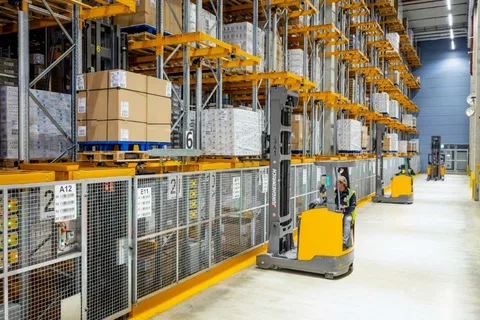In the modern age, with the rapid evolution of technology and industry, efficiency and speed have become paramount. This drive for optimization has led to the development of Automated Storage and Retrieval Systems (AS/RS). These systems, which are primarily used in manufacturing and distribution centers, provide solutions to store and retrieve items with minimal human intervention.
What is AS/RS?
An Automated Storage and Retrieval System (AS/RS) is a combination of equipment and controls that handle, store, and retrieve materials with precision, accuracy, and speed under a defined degree of automation. These systems vary in complexity but typically involve some form of racking, machinery, and a control system.
Types of AS/RS
There are several types of ASRS systems, each tailored to specific needs:
- Unit-load AS/RS: Designed for handling large loads. These typically involve pallet-sized loads and use forklift-like machines or cranes.
- Mini-load AS/RS: Handle smaller loads, often contained in totes or cartons. They are typically faster than unit-load systems and use robotic arms or shuttles.
- Horizontal Carousels: Rotating shelves that move horizontally and can quickly bring an item to the operator.
- Vertical Carousels: Similar to horizontal carousels but rotating vertically, they are often used for storing small items or files.
- Vertical Lift Modules (VLMs): These consist of two columns of trays with an inserter or extractor in the center that can shuttle items to and from storage positions.
- Shuttle Systems: Independent, self-powered vehicles that move along the storage shelves.
Benefits of AS/RS systems
Implementing an AS/RS can lead to numerous advantages, including:
- Space Saving: Due to high-density storage, floor space can be used more efficiently
- Increased Accuracy: Automated systems reduce human errors in picking and placing
- Higher Throughput: AS/RS can operate at high speeds, thus increasing the rate of storage and retrieval
- Reduced Labor Costs: Automation reduces the need for manual labor, especially for repetitive tasks.
- Enhanced Safety: Reducing human interaction in storage areas can lead to fewer accidents and injuries
Components of AS/RS
Typically, an AS/RS comprises:
- Storage Aisle: The central component where items are stored and retrieved
- Rack Structure: Shelves or slots where items are stored
- Storage and Retrieval Machine (S/RM): The machinery that moves to pick or store items
- Input/Output Points: Where items enter or exit the system
- Computer Control System: Directs the S/RM to where items need to be stored or picked
Integration with Other Systems
For optimal efficiency, AS/RS often integrates with:
- Warehouse Management Systems (WMS): Software solutions that manage inventory and order processing
- Conveyor Systems: Transport items to and from the AS/RS
- Order Picking Systems: Direct and optimize the picking of items for shipment
The Future of ASRS Systems
As technology continues to evolve, so does the potential for AS/RS. With the rise of the Internet of Things (IoT), Artificial Intelligence (AI), and more advanced robotics, AS/RS can become even more efficient, adaptable, and integrated with other systems. The future could see these systems becoming self-optimizing, learning from previous actions, and even predicting future storage and retrieval needs.
Conclusion
Automated Storage and Retrieval Systems represent a leap forward in the optimization of storage and retrieval processes. As industries continue to grow and the demand for quicker, more efficient methods of handling goods rises, the importance and relevance of AS/RS will only become more pronounced. Whether you’re a business owner looking to streamline your operations or a curious individual eager about the future of automation, understanding AS/RS is key to envisioning the future of warehousing and logistics.







